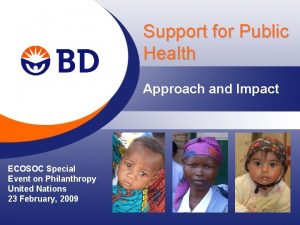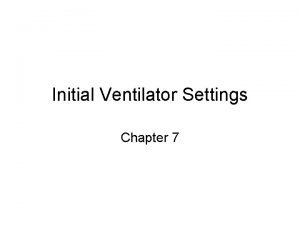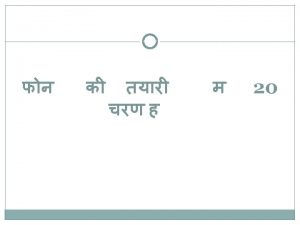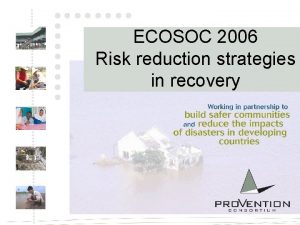Health for All in LowIncome Settings ECOSOC March































- Slides: 31

Health for All in Low-Income Settings ECOSOC March 31, 2009

Severe malaria

The 1948 Constitution of the World Health Organization declares the highest attainable standard of health to be a fundamental human right, “without distinction of race, religion, political belief, economic or social condition. ” The Universal Declaration of Human Rights of the same year declares the right to security in the event of sickness. The Alma Ata Declaration of 1978 called for “Health for All by 2000” through access to primary health facilities. The Millennium Development Goals adopted in 2000 call for a reduction of child mortality by two-thirds, maternal mortality by three-fourths, and the control of AIDS, malaria, and other diseases, by 2015 compared with a 1990 baseline.

Decade of Scaling Up, 2000 -2010: Backdrop (failure of Health for All, pandemics, structural adjustment, aid stagnation) • Commission on Macroeconomics and Health (2000) • Global Alliance for Vaccines and Immunizations (2000) • Millennium Development Goals (2000) • Gates Public-Private Partnerships (2000) • AIDS, TB, Malaria (commitments, initiatives) (2000, 2001) • Global Fund to Fight AIDS, TB, and Malaria (2001) • Measles, Polio, NTDs (25+ years) • Non-Communicable Diseases (2000) • Disease Control Priorities in Development Countries (DCPP) • Human Resource for Health (2004) • UN Millennium Project Report (2005) • Millennium Villages (2005) • Community Health Workers (NRHM, Ethiopia, others) • m. Health, RDTs, and other technological advances

19 80 19 81 19 82 19 83 19 84 19 85 19 86 19 87 19 88 19 89 19 90 19 91 19 92 19 93 19 94 19 95 19 96 19 97 19 98 19 99 20 00 20 01 20 02 20 03 20 04 20 05 20 06 20 07 10 5 Aid for Health and Population 9 8 7 6 ODA (2006 USD billions) 4 3 2 1 0

The Continuing Health Financing Gap for the Poorest 1 billion: Roughly $50 billion per year needed ($50 per capita), of which: • $12 billion from low-income countries • $10 billion in existing aid (roughly 0. 03 percent of GDP) Financing Gap: • $28 billion per year from donors (0. 07 percent of GDP)

Fundamental Public Health Approach Epidemiology Interventions (within and beyond health system) Systems Design Management Planning and Implementation • Investment • Training • Community empowerment • Oversight • Monitoring, evaluation, feedback Financing Feedback

Epidemiology: Category I: Infection, Nutrition, Safe Childbirth Category II: Non-Communicable Disease Category III: Violence and Accidents

DALYs by Region


Underlying causes related to: • Tropical Ecology • Unsafe Water • Indoor Air Pollution • Nutritional Deficiencies • Lack of Preventative Health Services • Lack of Clinical Health Services • Lack of Family Planning and Contraception • Lack of Safe Delivery and Neonatal Care POVERTY IS THE MAIN UNDERLYING CAUSE

Intervention Strategies: • Deploying Scalable, Replicable Proven Interventions • Combining Health Sector and Non-Health Sector Interventions • Combining Prevention and Treatment • Empowering Households • Mass application where feasible (bed nets, vaccines, nutrition) • Application of m. Health strategies for scale up

Success Stories in the Control of Neglected Tropical Disease


Some Recent Expenditure Date (2003): Public Sector Outlays for Health, per capita Kenya Malawi Mali $8 $5 $9 Brazil Mexico Thailand $96 $172 $47 Canada United States $1, 866 $2, 548


Holistic Approaches to Community-led development through Millennium Villages

Millennium Villages

Core Interventions: • Agriculture (inputs, diversification, business development) • Health (clinical care, CHWs, nutrition, emergency services) • Education (school facilities, teachers, school meals, ICTs) • Infrastructure (roads, power, connectivity, water and sanitation) • Business development (microfinance, farmer cooperatives, agricultural financing)

Core Health Interventions in the MVs • Clinical Health Services • Community Health Workers • Routine Prevention (vaccines, de-worming, • Mobile Health and ICT services • Emergency Care • Safe Delivery • Family Planning • Additional Services: dental, eye, CVD malaria control)

Ten Steps to Health for All in the Poorest Countries

1. Rich countries should devote 0. 1 percent of GNP $35 billion per year as of 2006) to health assistance for poor countries in order to close the financing gap of the primary health system

2. Half of that could effectively be channeled through the Global Fund to Fight AIDS, TB, and Malaria

3. Low-income countries would fulfill the Abuja Commitment of allocating at least 15 percent of domestic revenues to the health sector. Total spending (domestic and external funding) should be greater than $50 person per year in order to ensure basic health services.

4. The world would adopt a plan for comprehensive malaria control by 2010, with an end of malaria mortality by 2012 (estimated cost $3 billion per year)

5. The G-8 would fulfill the commitment to universal access to ARVs by 2010

6. The world would fulfill the Global Plan to Stop TB, including closing the financing gap of $3 billion per year.

7. The world would fulfill the funding for access to Sexual and Reproductive Health Services, including emergency obstetrical care and contraception, by the year 2015

8. The Global Fund would establish a window for 7 neglected tropical diseases which can be controlled by mass chemotherapy: hookworm, ascariasis, trichuriasis, onchocerciasis, schistosomiasis, lymphatic filariasis, and trachoma

9. The Global Fund would establish a window for health systems, including mass training of community health workers

10. The world would introduce primary health care (mass prevention and treatment) of non-communicable diseases, including: oral health, eye care, mental health, cardiovascular disease, and metabolic disorders, including measures on lifestyle (smoking, trans-fats, urban design for a healthy environment), surveillance, and clinical care.
 Poland national anthem lyrics
Poland national anthem lyrics Communication cycle in health and social care
Communication cycle in health and social care Handling information in health and social care
Handling information in health and social care Name all the lines name all the segments name all the rays
Name all the lines name all the segments name all the rays Fspos vägledning för kontinuitetshantering
Fspos vägledning för kontinuitetshantering Novell typiska drag
Novell typiska drag Nationell inriktning för artificiell intelligens
Nationell inriktning för artificiell intelligens Vad står k.r.å.k.a.n för
Vad står k.r.å.k.a.n för Varför kallas perioden 1918-1939 för mellankrigstiden?
Varför kallas perioden 1918-1939 för mellankrigstiden? En lathund för arbete med kontinuitetshantering
En lathund för arbete med kontinuitetshantering Adressändring ideell förening
Adressändring ideell förening Tidbok
Tidbok Sura för anatom
Sura för anatom Förklara densitet för barn
Förklara densitet för barn Datorkunskap för nybörjare
Datorkunskap för nybörjare Tack för att ni lyssnade bild
Tack för att ni lyssnade bild Debattinlägg mall
Debattinlägg mall För och nackdelar med firo
För och nackdelar med firo Nyckelkompetenser för livslångt lärande
Nyckelkompetenser för livslångt lärande Påbyggnader för flakfordon
Påbyggnader för flakfordon Formel för lufttryck
Formel för lufttryck Offentlig förvaltning
Offentlig förvaltning Jag har gått inunder stjärnor text
Jag har gått inunder stjärnor text Presentera för publik crossboss
Presentera för publik crossboss Teckenspråk minoritetsspråk argument
Teckenspråk minoritetsspråk argument Vem räknas som jude
Vem räknas som jude Treserva lathund
Treserva lathund Fimbrietratt
Fimbrietratt Bästa kameran för astrofoto
Bästa kameran för astrofoto Cks
Cks Lågenergihus nyproduktion
Lågenergihus nyproduktion Mat för idrottare
Mat för idrottare























































